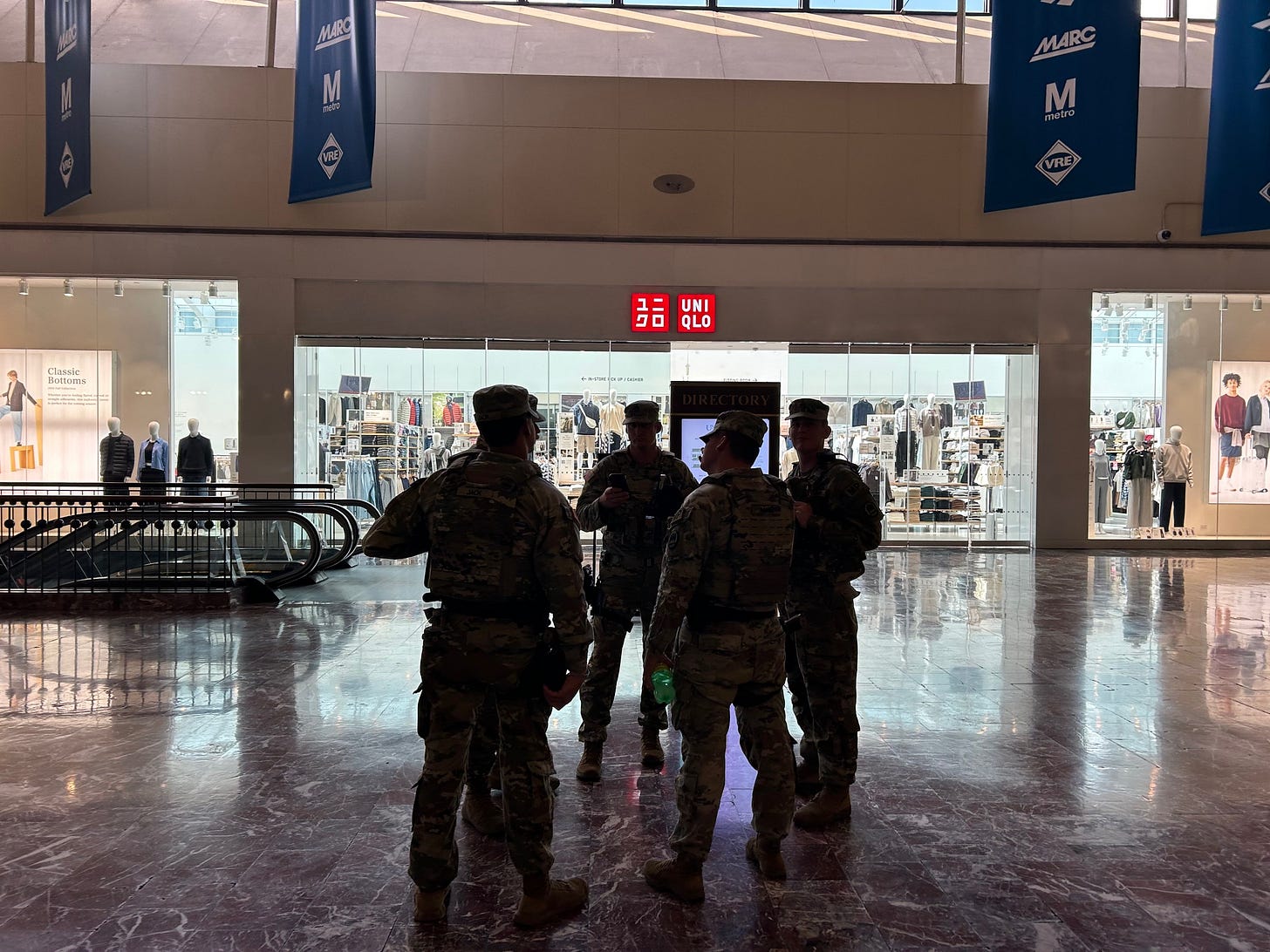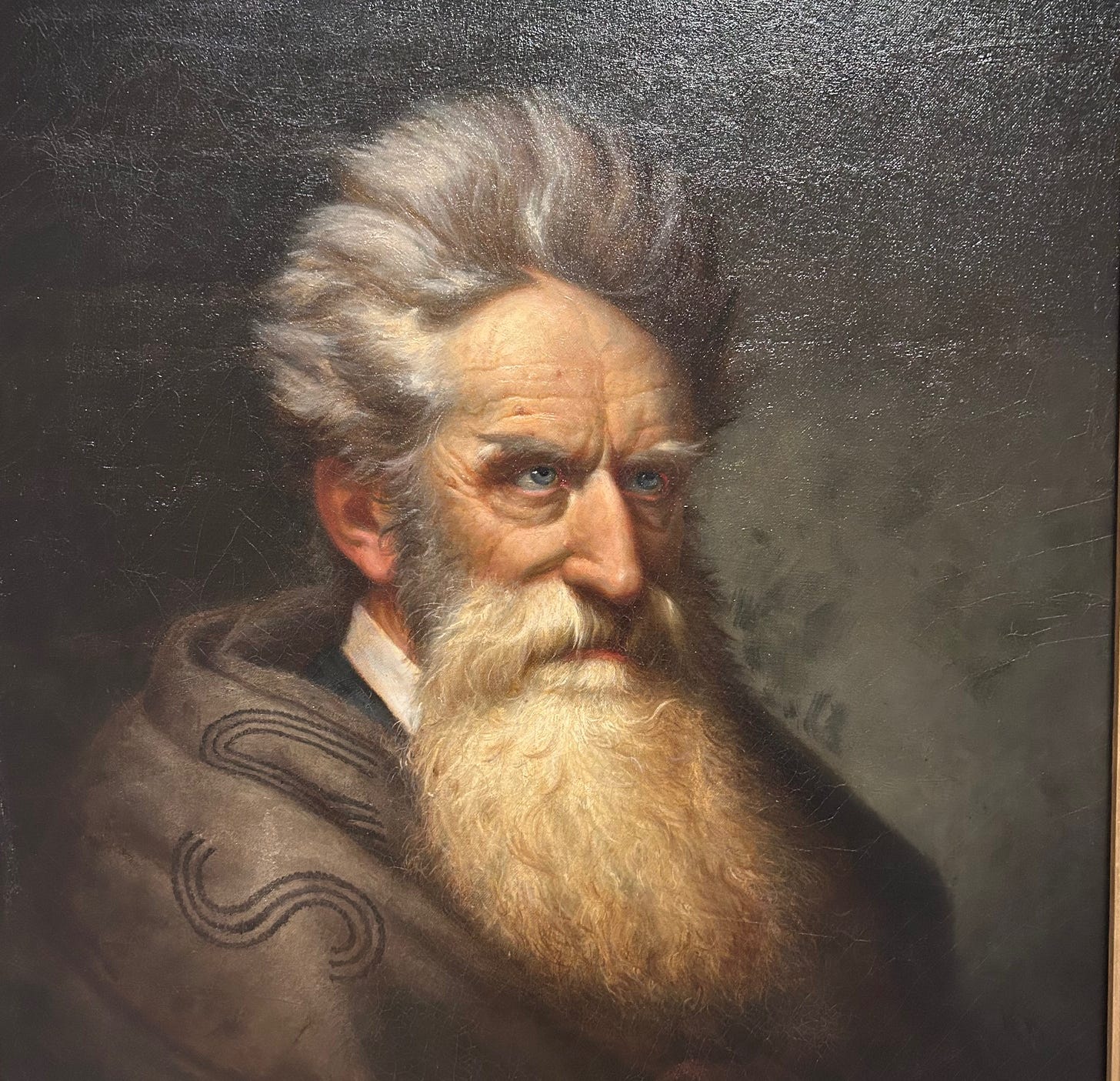Symbolic Battlefields
Fighting to tell America's story.
“Pierre L’Enfant’s original plan for the capital,” an official Smithsonian Institute history notes, “included a designated site, at 8th and F streets N.W., for a national, nondenominational church or pantheon for the nation’s heroes.” The site became home to a grand, Greek revival-style patent office. It was where Abraham Lincoln hosted his inaugural ball in March of 1865, at the same time that General Sherman’s troops were cutting their righteous path of destruction through South Carolina.
Today, the building is home to the Smithsonian American Art Museum and the National Portrait Gallery. On the top floor, suspended from the soaring ceiling, two hundred identical golden arms with clenched fists hang in an undulating pattern, like a hundred-foot-long snake that has leapt in through the overhead skylight. Each arm is a life-sized reproduction of the arm of sprinter Tommie Smith—the arm he famously raised with a gloved Black Power fist on the podium at the 1968 Olympics. The artwork, called Bridge, is staggering. It is impossible not to imagine a thunderbolt causing the entire thing to shake loose and plunge down through the floor, two hundred blows aimed at the heart of the country.
Smith, who parlayed his lone moment in the global spotlight into an iconic moment, understood the power of symbolism. It is no surprise that his act of defiance ended up cast in metal and hung in the Smithsonian. What is a museum, after all, but an official story told in symbols?
In June, Kim Saject, the director of that museum, resigned. The pressure on her had been growing ever since Donald Trump condemned her as “partisan” and “highly supportive of DEI.” One wonders if Tommie Smith, fist aloft on that podium, could have foreseen all of this. I suspect he would have been unsurprised. It is precisely because symbols have power that they are fought over. A president who used that power to elevate himself in the world has turned his attention to the symbolic battlefield of America itself.
“President Trump Is Right About the Smithsonian” declared an official White House statement a week ago. It waved around, triumphally, examples of blatant viewpointism contained within the walls of our national museums. A series about the border wall at the National Portrait Gallery! An LGBTQ flag at the American History Museum! At the National Museum of African Art, a shocking bias against the middle passage! A picture of Anthony Fauci’s head!
After prowling the halls of the National Portrait Gallery myself last week, I was forced to admit that Trump has a point. Placards next to paintings of dead old white men often referenced the fact that those men had done certain things that appear unsavory to our modern eyes—without referencing, say, their favorite ice cream flavors, or whether they liked kittens, or other redeeming factors. Philosopher George Berkeley’s plan “was to transport young Native Americans to Bermuda (by force, if necessary), convert them to Christianity, and train them alongside young Englishmen.” South Carolina statesman Charles Cotesworth Pinckney’s “wealth stemmed from the labor of those he enslaved on his plantation.” Of Francis Scott Key’s patriotic masterpiece, the museum writes, “abolitionists noted the irony of a song about ‘the land of the free’ written by a staunch advocate of slavery with narrow views of freedom.” There is even a portrait of John Brown, wild-haired and intense, with no asterisk condemning the fact that he broke laws duly passed by honorable members of Congress.
The symbolic wars of recent decades were waged to open cracks in the smooth and simple stories of American history and insert, amid the myths, some notes on the foul-smelling truths. The backlash to these tentative symbolic steps forward is now in full effect. It may seem frivolous for a US President to waste his precious time railing against the editorial choices of portrait gallery directors, but these are meaningful fights for those who are today’s equivalent of the Great Men whose portraits have ended up on the museum’s walls. If the rulers of the past are destined to end up remembered for their villainy, might the rulers of today suffer the same fate after they are gone? It is a paralyzing thought for those concerned above all with self-glorification. And so the struggles for the minds of the future are fought on the symbolic battlefields of today.
There is no more appropriate setting for this than Washington, DC, the city most defined by symbolism. Even the flesh-and-blood soldiers who have been placed in the city’s streets are little more than advertisements for a brand of power that exists in Donald Trump’s imagination. The National Guardsmen patrolling Union Station looked ridiculous, milling around outside of the Uniqlo and resting their hands on machine guns as commuters strode by clutching Cinnabons. They all seemed to be struggling with the surreality of their own position. People constantly took photos of them, and the younger soldiers, the ones sporting the kind of absurd cop mustaches that young men grow to prove that they can, would smile or wave or mug for the cameras. This would draw not a friendly wave but a look of disgust from the passing DC residents, who didn’t want them there in the first place. Then the sheepish soldier would redden and turn and hook his thumbs in his bulletproof vest, his hero fantasy undermined by a hostile populace. No one on either side seemed to know what the fuck the point of it all was.
The confusion would be mitigated if everyone understood that we are all being cast as unwilling actors in the drama of a man who used reality television to achieve real power, and is now repeating that procedure with dramatically higher stakes. This show is on every channel and nobody can turn it off. The commercials are intrusive and they can’t be fast-forwarded. In the end the winner will be grandly revealed, and all of the losers will be cast out into the gulags.
It is tempting, but inaccurate, to see Trump as something new. He is but a more potent version of an old poison. On Pennsylvania Avenue one block north of the contested Smithsonians sits the Department of Justice building. It is named for Robert F. Kennedy. Now it is occupied by Pam Bondi, who is using the department as an authoritarian weapon, and Robert F. Kennedy’s son is dismantling a century’s worth of public health infrastructure in a way that could cost millions of lives. There is an easy narrative there, all laid out before you: The good Kennedy gave way to the bad, Camelot descended into hell, and we are all searching for new versions of the heroes whose legacies are being cynically besmirched.
That is the sort of pat narrative thinking that led Americans to embrace The Apprentice. What was the original sin? An ambitious businessman uses a World War to forge political connections, and builds a fortune on booze, banks, and movies. He propels his lascivious son into the White House, and that son in turn picks his own brother as attorney general (a level of nepotistic corruption that not even Trump has matched). The brothers’ Hollywood good looks, their sun-kissed faces and alluring chapped lips, their mastery of television and glamour in an age of sweaty politicians with thinning hair, bought them a Get Out of Judgment Free pass just as surely as Donald Trump would later purchase his own using casinos and catchphrases and golden toilets. America’s stubborn belief in Great Man Theory, our needy desire for salvation, our abject acquiescence to rich men who want to buy the White House—these things we have seen before. Only the details change. For all of our flag-waving and weepy paeans to democracy, we are forever secretly hoping to recreate the Royal Family on our own shores.
The symbolic world creates the real world. That is what all of these powerful people know. It is absurd, yes, but we will all find ourselves scoffing at its ridiculousness even as it comes to define our entire lives. The only relevant question is when the real world chooses to reach up for primacy once again. It happened to some people when they staggered onto the beach at the Bay of Pigs, and it happened to other people when an assassin’s bullet blew their brains out. We are writing an exciting new chapter in American history. We will all tune in for its ending. And later, the zealots of the future will draw their knives and fight over how to tell this story inside of a beautiful museum.
Happy Labor Day
I dislike obligatory “The State of Labor” essays published on Labor Day, and now that I work for myself, I don’t have to write them any more. Here at How Things Work, every day is Labor Day. Still, it is good today to take a moment to think about The Fucking Struggle. Unionize your workplace and join the labor movement. We need everyone in our army.
For help organizing your workplace, contact EWOC. To read the dozens of articles on labor and unions that How Things Work has published in the past two years, scroll down this page. There is no paywall on this site, and the archives are free for all to read. To support my work and help this publication continue publishing, take a second to become a paid subscriber today. Our funding comes directly from all of you. Thank you for being here. See you in the streets compadres.
More
Related reading: A Television Show Called The USA; Revolution Town; You Are Invited to the Predator’s Ball, As Food.
If you are interested in how the labor movement can save America from the situation we are currently in, pick up a copy of my book “The Hammer,” which is about that very topic. On September 20th, I will be speaking in Atlanta at the annual Douglass-Debs Dinner held by the Atlanta DSA. Tickets are available here.
In addition to How Things Work, here are some other sources for high quality labor reporting: In These Times, Jacobin, The Real News, Labor Notes, The American Prospect, Kim Kelly. I hope that you read and support the relatively few journalists doing this work.




On "Labor Day" do not forget Haymarket, May 4, 1886 in Chicago. Much of the rest of the world celebrates International Workers Holiday on May 1st each year. US capitalists refuse to acknowledge the value of workers rising up, so we have today, our unique Labor Day, a celebration of labor I guess, but more precisely perhaps the profit it creates for the owners.
Chilling 💔
Glad to be an old woman.
History shouldn't be kind to this cretin and his moronic band of grifters😱👊👊👊